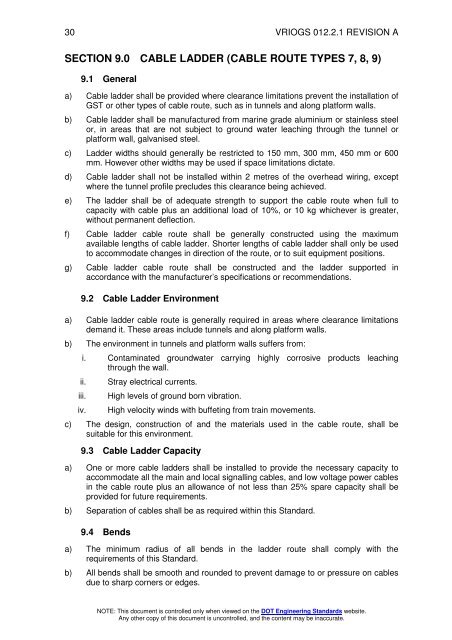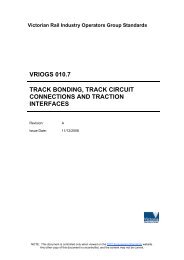VRIOGS 012.2.1 - Public Transport Victoria
VRIOGS 012.2.1 - Public Transport Victoria
VRIOGS 012.2.1 - Public Transport Victoria
Create successful ePaper yourself
Turn your PDF publications into a flip-book with our unique Google optimized e-Paper software.
30 <strong>VRIOGS</strong> <strong>012.2.1</strong> REVISION A<br />
SECTION 9.0 CABLE LADDER (CABLE ROUTE TYPES 7, 8, 9)<br />
9.1 General<br />
a) Cable ladder shall be provided where clearance limitations prevent the installation of<br />
GST or other types of cable route, such as in tunnels and along platform walls.<br />
b) Cable ladder shall be manufactured from marine grade aluminium or stainless steel<br />
or, in areas that are not subject to ground water leaching through the tunnel or<br />
platform wall, galvanised steel.<br />
c) Ladder widths should generally be restricted to 150 mm, 300 mm, 450 mm or 600<br />
mm. However other widths may be used if space limitations dictate.<br />
d) Cable ladder shall not be installed within 2 metres of the overhead wiring, except<br />
where the tunnel profile precludes this clearance being achieved.<br />
e) The ladder shall be of adequate strength to support the cable route when full to<br />
capacity with cable plus an additional load of 10%, or 10 kg whichever is greater,<br />
without permanent deflection.<br />
f) Cable ladder cable route shall be generally constructed using the maximum<br />
available lengths of cable ladder. Shorter lengths of cable ladder shall only be used<br />
to accommodate changes in direction of the route, or to suit equipment positions.<br />
g) Cable ladder cable route shall be constructed and the ladder supported in<br />
accordance with the manufacturer’s specifications or recommendations.<br />
9.2 Cable Ladder Environment<br />
a) Cable ladder cable route is generally required in areas where clearance limitations<br />
demand it. These areas include tunnels and along platform walls.<br />
b) The environment in tunnels and platform walls suffers from:<br />
i. Contaminated groundwater carrying highly corrosive products leaching<br />
through the wall.<br />
ii.<br />
iii.<br />
iv.<br />
Stray electrical currents.<br />
High levels of ground born vibration.<br />
High velocity winds with buffeting from train movements.<br />
c) The design, construction of and the materials used in the cable route, shall be<br />
suitable for this environment.<br />
9.3 Cable Ladder Capacity<br />
a) One or more cable ladders shall be installed to provide the necessary capacity to<br />
accommodate all the main and local signalling cables, and low voltage power cables<br />
in the cable route plus an allowance of not less than 25% spare capacity shall be<br />
provided for future requirements.<br />
b) Separation of cables shall be as required within this Standard.<br />
9.4 Bends<br />
a) The minimum radius of all bends in the ladder route shall comply with the<br />
requirements of this Standard.<br />
b) All bends shall be smooth and rounded to prevent damage to or pressure on cables<br />
due to sharp corners or edges.<br />
NOTE: This document is controlled only when viewed on the DOT Engineering Standards website.<br />
Any other copy of this document is uncontrolled, and the content may be inaccurate.

















